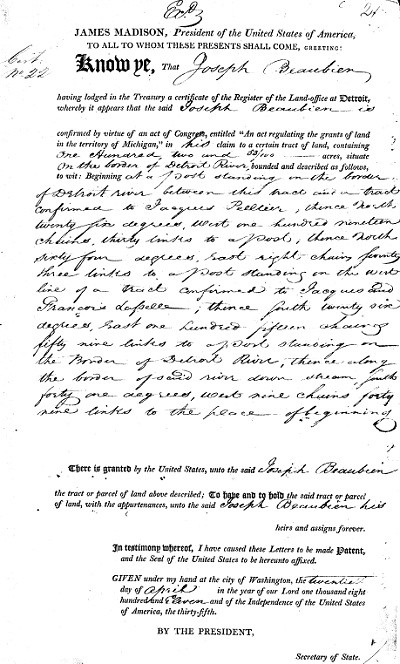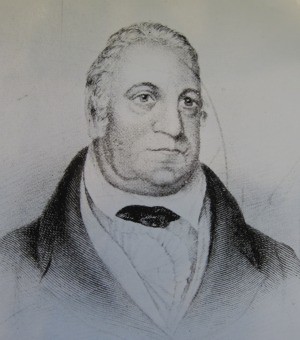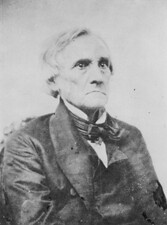
The Joseph Kingston House, 1560 Bagley, Detroit
The Kingston House's current owner, Scott Robichaud, purchased the home in 2007 and has kept the blog Redemption in Corktown to document its extensive renovation. Fortunately for me, he already did some of the research on the house and posted plenty of photos on his blog, both of which he has permitted me to use. But first, the land:
Robert Navarre
 |
Robert Navarre was born in 1709 in Villeroy, France. It is not known when he came to Canada, but he was sent to Detroit as early as 1728 to serve as sub-intendant of the settlement. He was soon after instated as Royal Notary, making him "the record keeper, the lawyer, the general scrivener, the surveyor, tithe gatherer, tax collector, treasurer of the king's revenue, and perhaps the school teacher of the settlement" (Burton 703). Navarre married Marie Lootman dit Barrois at Detroit on February 10, 1734.
On May 1, 1747, the Canadian government granted Navarre a parcel of land measuring 3 by 40 arpents on the Detroit River (Farmer 20). This was the first land grant made west of the fort--until then, all concessions had been on the east.

Navarre executed his duties so faithfully that the British government kept him on after gaining control over the territory in 1760. He retired two years later and lived on his farm for the rest of his life.
After Navarre passed away on November 21, 1791, the land became the property of his son, Francois. By that time, he had already settled on land in Monroe County deeded to him by the Potawatomi Indians. Francois Navarre sold the inherited land to his cousin Joseph Beaubien on September 12, 1797.
Little is known about Joseph Beaubien outside of a few vital records. He was born in Detroit on March 20, 1752 and married Marie-Josephe Bondy on March 10, 1777. He was not the man for whom Beaubien Street was named--that was his younger brother, land owner Lambert Cullier dit Beaubien.
Joseph Beaubien owned the farm during the transfer of power between the British and American governments. The United States granted Beaubien a land patent for the farm, which designated Private Claim No. 22, on July 16, 1807.

Land patent for Private Claim No. 22 (Source)
Beaubien sold the farm three years later, on November 15, 1810, to an English merchant named James May. Beaubien died in March of 1821.

Image courtesy of the Burton Historical
Collection, Detroit Public Library
Born in Birmingham, England in 1756, James May came to Canada in 1775 and settled in Detroit in 1778 at the age of 19. He served as associate Judge of Common Pleas in Detroit in 1788, and was appointed Chief Justice of that court in 1800. A year after Detroit was incorporated as a town in 1802, May was elected as one of five trustees.
James May owned the Navarre Farm when Detroit fell to the British during the War of 1812. Allegedly, May took possession of Fort Shelby's American flag and hid it until the British departed one year later, when he raised it once more (Ross 141). James May died in Detroit on January 19, 1829.

(Source)
William Woodbridge was born in Norwich, Connecticut on August 20, 1780. He came to Detroit in 1814 after accepting President James Madison's appointment as Secretary of the Territory of Michigan.
On October 1, 1819, Woodbridge purchased the former Navarre Farm from James May. He would live on the farm for nearly forty years. Woodbridge went on to serve as as the Michigan Territory's delegate to Congress (1819-1820), the second Governor of Michigan (1840-1841), and a United States Senator (1841-1847).
Soon after land patents were issued in Detroit, farmers were allowed to double the size of their property by claiming an additional tract of land behind their current one. The farm Woodbridge bought from James May now consisted of Private Claims Nos. 22 and 26. In addition to those, Woodbridge purchased the farm immediately to the east, Private Claim No. 248 (the Lasselle Farm), which was also extended to include Private Claim No. 27. The massive Woodbridge Farm was now approximately 1,100 feet wide and extended three miles inland.

By an act of the Michigan Legislature on February 12, 1857, the City of Detroit expanded its borders to include that portion of Springwells Township on which the Woodbridge Farm was situated (minus the few acres north of the railroad tracks in Private Claim No. 26). This forced Woodbridge's land to be subject to the laws, ordinances, and high taxes of the growing urban center. He fought what he perceived to be an infringement upon his rights (Lanman 67), but he was unsuccessful. On September 14, 1858, he submitted to the Wayne County Register a plan for the subdivision of his property which would be sold in lots.

Detail from 1910 copy of 1858 platting of the Woodbridge Farm. (Source)
The lot where the Kingston House stands is highlighted in red.
Woodbridge named the 100-foot-wide thoroughfare that would run through his former farm Trumbull Avenue after his father-in-law, John Trumbull. There was a wooded area northwest of Michigan and Trumbull Avenues that Woodbridge let open to the public as a picnic grounds that became known as "Woodbridge Grove". Apparently, that parcel of land would later become associated with baseball.
Despite Woodbridge's misgivings about Detroit's expansion, it had greatly increased his net worth. The 1860 Census indicated that the value of his real estate was $300,000--over $7 million today. William Woodbridge died on October 20, 1861.
Just a few months before he passed away, Woodbridge sold lot number 9 of block 77 of his former farm to an immigrant from County Cork, Ireland named Joseph Kingston. It appears that the house Kingston was living in on that lot had already been there for at least four years. But that's an issue to be covered next time...
Next week: The Kingston House Part II: 1861-1899 -- Joseph Kingston
--Bibliography--
Burton, Clarence. The City of Detroit Michigan 1701-1922. Volume II. Detroit: S. J. Clarke Publishing, 1922.
Farmer, Silas. The History of Detroit and Michigan: Or, The Metropolis Illustrated. Detroit: Silas Farmer & Co., 1884.
Lanman, Charles. The Life of William Woodbridge. Washington: Blanchard & Mohun, 1867.
Ross, Robert B. The Early Bench and Bar of Detroit from 1805 to the end of 1850. Detroit: Winn and Hammond, 1907.

Awesome history. This helps me out a lot with history research that I'm conducting for my thesis study.
ReplyDeleteNice post. I love to read an interesting blog that has the knowledge to impart. Keep on sharing the blog like this.
ReplyDeleteRenovations in Kingston
Hey Paul, can you perhaps connect me with your source? My ancestor is Robert Navarre and I am looking to see all I can about him in my upcoming visit to Detroit.
ReplyDelete